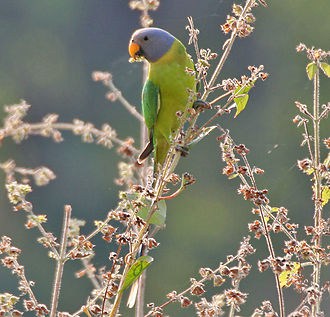Type the name of the breed you're looking for below
[wpdreams_ajaxsearchlite] Don't see the breed your're looking for? Click here and let us know!
Plum Headed Parakeet
| Origin | The Plum Headed Parakeet is a parakeet endemic to the Indian Subcontinent. |
| Size | Can grow up to 14 in(35 cm) |
| Lifespan | Can live 15+ years |
| Noise | They are noisy, always active and showy, and are very fast with their direct flight. |
| Characteristics | The male has a red head which shades to purple-blue on the back of the crown, nape and cheeks while the female has blueish-grey head. There is a narrow black neck collar with verdigris below on the nape and a black chin stripe that extends from the lower mandible. There is a red shoulder patch and the rump and tail are bluish-green, the latter tipped white. The upper mandible is orangish-yellow, and the lower mandible is dark. The female has a dull bluish grey head and lacks the black and verdigris collar which is replaced by yellow. The upper-mandible is corn-yellow and there is no black chin stripe or red shoulder patch. Immature birds have a green head and both mandibles are yellowish. The dark head is acquired after a year. |
| Abilities | Can be taught to mimic human speech. Some species can learn up to 500 words. |
| Interaction/Time Requirements, Diet, Supplies Needed | Aviaries are sold ready for home assembly. Parrots do well in aviaries and cages. They don't like to be in crowded spaces and will sometimes be aggressive towards other birds if they don't have enough space. Parrots can also be hand reared, provided that they have a large cage and are taken out of their cage on a daily basis to prevent boredom, as it may result in the parrot pulling out its feathers to occupy itself. They require a warm habitat for the winter months. Do not allow your birds outdoors until all signs of frost are gone. Space is important and indoor cages should be as large as possible. A large cage is required even if the bird is going to spend lots of time out of its habitat with you. They eat a foreign seed mixture that contains various millets and other small seeds such as niger. You need to change food and water twice daily, and clean the cage at least once a day, replacing toys and broken climbing branches. Parrots are escape artists, be sure to secure the cage or aviary. |



